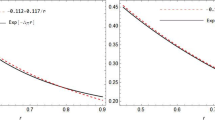Summary
We calculate thep- andd-wave nonstrange-baryon spectrum in a diquark-quark model, where diquarks are assumed to be elementary objects. The potential between a quark and a diquark is Coulombic at short distances due to one-gluon exchange and the confining potential is linear at large distances. Splitting between various states is calculated using a Breit-Fermi Hamiltonian for the diquark-quark system. It is assumed that baryonium states are composed of a diquark and an antidiquark. The level splittings are computed by fixing all parameters from the existing baryon spectrum.
Riassunto
Si calcola lo spettro dei barioni non strani delle ondep ed in un modello diquark-quark in cui si ipotizza che i diquark siano oggetti elementari. Il potenziale fra un quark e un diquark è di Coulomb a brevi distanze per lo scambio di un gluone e il potenziale di confinamento è lineare a lunghe distanze. La separazione fra vari stati si calcola usando una hamiltoniana di Breit-Fermi per il sistema diquark-quark. Si ipotizza che gli stati del barionio siano formati da un diquark e da un antidiquark. Le separazioni dei livelli sono calcolate fissando tutti i parametri dallo spettro barionico esistente.
Резюме
Мы вычисляем спектр нестранных барионов в дикварк-кварковой модели, в которой предполагается, что дикварки являются злементарными объектами. Потенциал между кварком и дикварком является кулоновским на малых расстояниях, вследствие обмена одним глуоном. Потенциал удержания является линейным на больших расстояниях. Вычисляется расщепление между различными состояниями, используя гамильтониан Брайта-Ферми для дикварк-кварковой системы. Предпояагается, что состояния бариониума образовано дикварком и антидикварком. Опредеделяются расщепления уровней, фиксируя все параметрыиз существующего барионного спектра.
Similar content being viewed by others
References
R. H. Dalitz:Les Houches Lectures 1965, edited byC. De Witt andM. Jacob (New York, N. Y., 1965);J. J. J. Kokkedee:The Quark Model (New York, N. Y., 1969).
A. De Rújula, H. Georgi andS. Glasiiow:Phys. Rev. D.,12, 147 (1975).
C. Quigg andJ. L. Rosner: FERMILAB-Pub-79/22-THY. This review contains detailed references.
A. Chodas, R. L. Jaffe, K. Johnson, C. B. Thorn andV. F. Weisskopf:Phys. Rev. D. 9, 2599 (1974).
T. De Grand, R. L. Jaffe, K. Johnson andJ. Kiskis:Phys. Rev. D,12, 2060 (1975).
J. L. Rosner:Phys. Rev. Lett.,21, 950 (1968).
C. Rosenzweig:Phys. Rev. Lett.,36, 697 (1976).
Chan Hong-Mo andH. Hogaasen:Phys. Lett. B,72, 121 (1977).
M. Fukugita andT. H. Hanson: Rutherford Laboratory preprint, to be publishedB. Nicolescu:Nucl. Phys. B,134, 495 (1978);A. W. Hendry andI. Hinchliffe:Phys. Rev. D,18, 3453 (1978);S. Ono: DESY preprint (unpublished).
L. Montanet: CERN preprint EP/Phys. 77-22 (1977).
Chan Hong-Mo andH. Hogaasen:Nucl. Phys. B,136, 40 (1978).
H. J. Schnitzer:Phys. Rev. D,18, 3482 (1978).
B. D. Lichtenberg andL. J. Tassie:Phys. Rev.,155, 1601 (1967);A. N. Mitra:Nuovo Cimento A,56, 1164 (1968);B. D. Lichtenberg:Phys. Rev.,178, 2197 (1969);G. Preparata:Erice Lectures 1977;R. E. Cutkosky andR. E. Hendricks:Phys. Rev. D,16, 786 (1977).
J. F. Gunion andR. S. Willey:Phys. Rev. D,12, 174 (1975).
M. Zrakek, W. J. Metzger andR. T. Van de Walle:Phys. Rev. D (to be published).
N. Isgur andG. Karl:Phys. Rev. D,18, 4187 (1978).
For derivation of the Breit Hamiltonian seeH. A. Bethe andE. E. Salpeter:Quantum Mechanics of One- and Two-Electron Atoms (Berlin, Göttingen and Heidelberg, 1957);V. B. Berestetskii, E. M. Lifshitz andL. P. Pitaerskii:Relativistic Quantum Theory (London, 1971).
For consideration of various types of interaction kernels see the review talks byJ. D. Jackson, C. Quigg andJ. L. Rosner:Proceedings of the XIX International Conference on High-Energy Physics, Tokyo, Japan, 1978.
M. E. Rose:Elementary Theory of Angular Momentum (New York, N. Y., 1957), p. 117.
L. J. Reinders:J. Phys. G,4, 1241 (1978);B. R. Martin andL. J. Reinders:Phys. Lett. B,78, 144 (1978).
M. Jones, R. H. Dalitz andR. Horgan: Oxford preprint 38/77; we adopt theSU 6⊗O 3 that are uncontroversial in the above preprint.
Particle Data Group:Review of Particle Properties (1980).
G. Goldstein andJ. Maharana: unpublished.
Chan Hong-Mo: CERN preprint TH 2540.
Author information
Authors and Affiliations
Additional information
Traduzione a cura della Redazione.
Перевебно ребакцией.
Rights and permissions
About this article
Cite this article
Goldstein, G.R., Maharana, J. Diquark constituents of baryons and baryonium. Nuov Cim A 59, 393–411 (1980). https://doi.org/10.1007/BF02904682
Received:
Published:
Issue Date:
DOI: https://doi.org/10.1007/BF02904682



